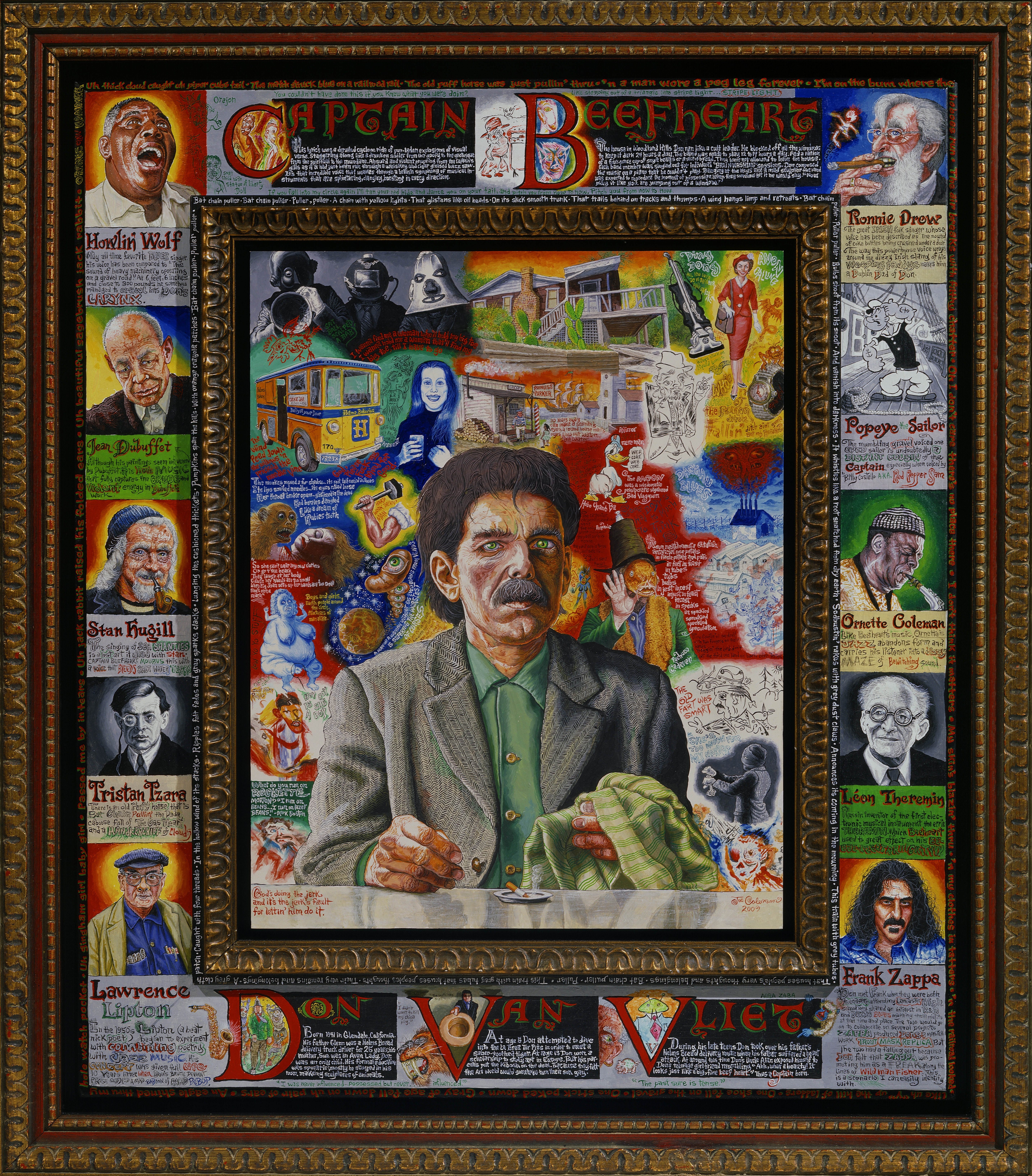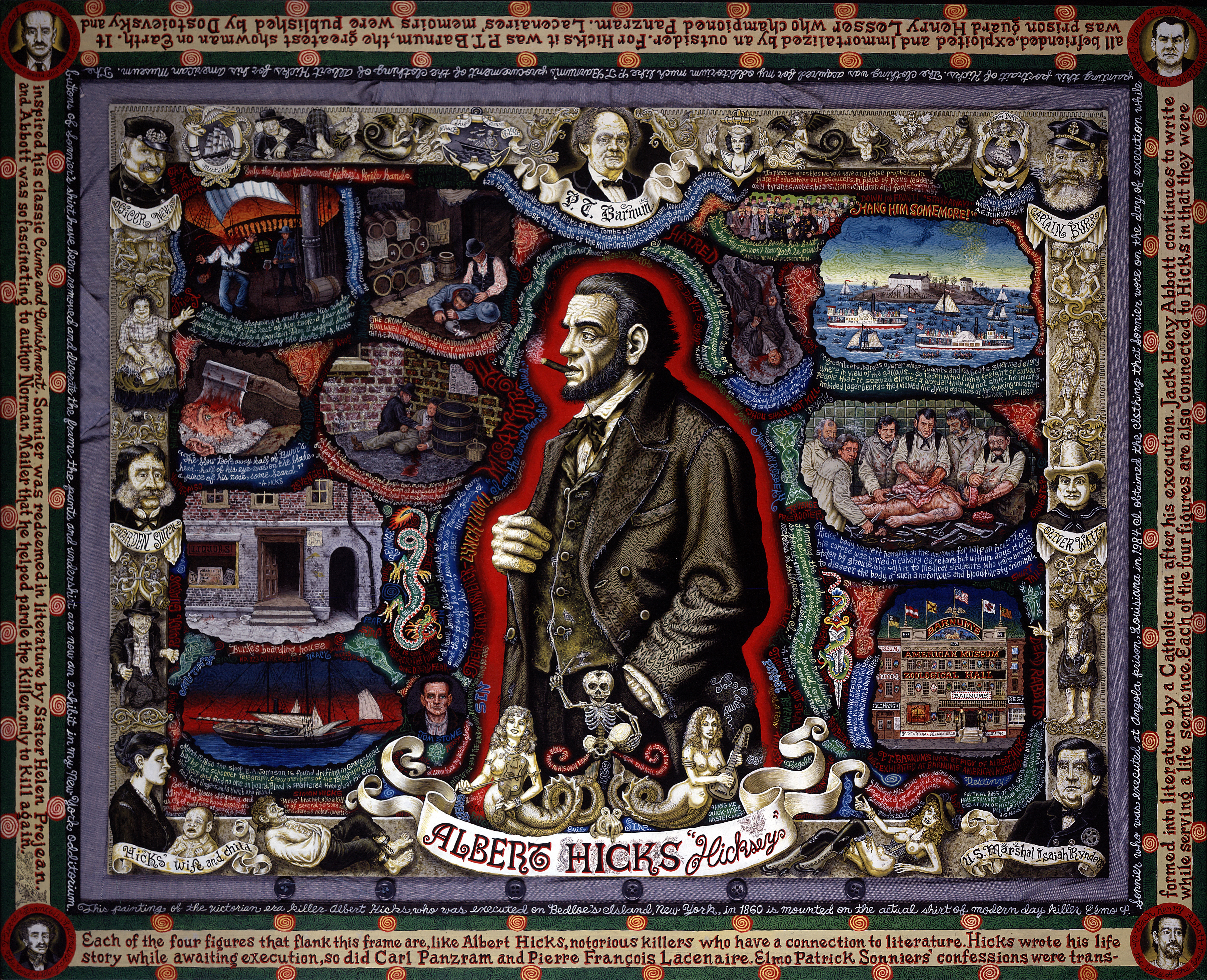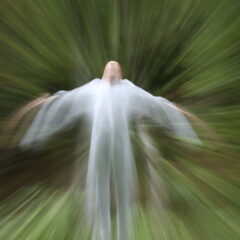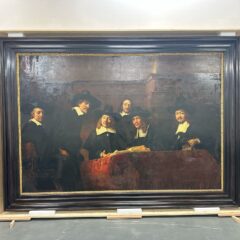Joe Coleman

This was the early 80s. I had arrived with a date at the Hotel Amazon in Downtown New York because the word was that Jello Biafra was likely to be doing a gig there and we passed a line of hipsters climbing stairs as we walked in. It turned out that they weren’t bound for the maybe happening but they were clearly going somewhere so we attached ourselves. The space we entered was seated and crowded, but with gaps to the front so we headed on down. The audience was dressed mostly in black, plenty of bikeresque leather, so my date, Diana, was looking fragile in white. We got seats in the first row. Great.
The fellow who came onstage had a jutting black beard and was dressed in the bravura manner of an old-school impresario, down to the ornamental waistcoat, but the look was somewhat skewed by a chunkiness to his frontage, not suggesting body-fat, more that he might be packing heat. The young woman who soon joined him on-stage looked lithe, self-possessed, like somebody used to getting attention, and duly got it, standing suddenly on her head so that her dress descended floorwards. The bearded man brought his arm down between her naked legs with the casual intensity of somebody hitting a punchbag in a gym. The attention level around us charted.

“I would have thought that would have hurt?” I said to Diana, puzzled.
She gave a numb nod. Meaning Yes.
The mystery of the black-bearded man’s lumpy frontage was resolved when he opened the waistcoat, exposing the firecrackers taped to his chest and lit them. As they were exploding he produced a white rat, put its head into his mouth, chomped down, flung the body aside, chose another white rat, another rat, another. I saw an exodus beginning alongside and behind us, with wave upon wave of black leather backs taking their leave, but Diana, less fragile than she looked, stuck in her seat while I, responding to visceral reportorial instincts – the story! the story!– clambered around on my hands and knees, looking for rat corpses, checking that they truly were headless. Which they were.
Reaching a pair of shoes, I looked up. The bearded man was looking down. Joe Coleman, the artist/performer, and I have been friends from that meeting on.
I would learn later that his female accomplice that evening had been another genre-redefining performer, Kembra Pfahler. And what I would soon also learn was that Coleman was a Performance artist, yes, but that beyond that he is an art maker, somebody who draws and paints, and who does so quite like no other.
Coleman is a hyper-realist. This is a term mostly applied to artists who have the skills to paint canvases that can be mistaken for photographs, frequently prompting an Okay! But why bother?, although sometimes interestingly as with the Car Reflections of Richard Estes. Nobody though can wring loaded meaning from the practice quite the way Coleman does, not just capturing every element in fastidious detail and melding them to deliver a powerful image but also in making sure that these details are charged with narrative data. Which, given the stories that Coleman will be compulsively telling, makes each painting at once a tempting dish and difficult to swallow.
So let’s have a walk-around of a show with the artist himself as guide, the show being Joe Coleman and the Shadow Self, which was at the Andrew Edlin Gallery on New York’s Bowery, eighteen months ago. I arrived to look over the work well ahead of our meeting to do my due diligence and I was de-coding Swift Runner and the Colonialist Windigo Effect, which he had painted the year before, when he was at my side.
This is, typically, a double-bladed story. Swift Runner, the central figure, was a Cree Indian who killed and devoured his family. So a monster, right? But this was during a famine induced by the settlers’ extermination of the buffalo. So there were other monsters too. But I began with a tech question. How does Coleman achieve that scary precision? A brush with a single hair, I guessed?
“One hair brush we call them, ” he said. “But it’s actually two hairs for the finest details. And I use jeweler’s lenses. I balance with just my pinkie and I barely move it for hours. I work an eight hour day on a single square inch without sketching out the whole thing. Most figurative painters sketch it out before. But I don’t. I react to each little detail that I put in.”
He works on hard surfaces, usually wood and will sometimes scrape out a completed square inch, but not too often. “Some of the paintings take four or five years to complete, the really big ones, ” he said. ”But even the smaller ones take up to a year to finish.” Several painters take time finishing their work, of course. But they will be working on many simultaneously.
And Coleman? “I work on one at a time, ” he says.

We moved on to A New York Pirate (A Portrait of Albert Hicks), which he made in 1997, and which is structured like an icon, with the cigar-chomping Hicks occupying the center panel and smaller images along the edges. “I don’t know if there’s anyone that paints like me, ” Coleman said. “I can’t think of anyone really, except maybe some of the medieval painters, the manuscript painters. I love Grunewald too, because there’s the detail but also a very emotional quality that I also strive for.”
And Albert Hicks? “He was a mercenary in the mid-1800s who hired himself out to the gangs of New York, ” Coleman said. “One night he was slipped a Mickey Finn in a dive and woke up in an oyster sloop headed to Virginia. So he killed the entire crew and the captain with an axe, then threw the bodies overboard. After he’d gone the sloop wandered into the harbor, like a ghost ship, covered with blood. They only found three fingers where one of the sailors had tried to hang on to the edge of the sloop. He was tried and became quite a celebrity. People came from all over to visit him. Barnum traded him a box of cigars for some of his possessions.”
There’s a strong investigative element to your pieces, I observed.
“Absolutely, ” said Coleman. ”They are like novels or short stories in which the entire story appears at once. So you have to take your own journey into it. And the more that you look, the more it reveals itself to you. But you are going to have to investigate the painting.”
Smaller portraits of four other killers are on the corners of the Hicks canvas, one being Elmo Patrick Sonnier, a murderer and rapist, executed in 1984. “He was this fascinating character who is portrayed by Sean Penn in the movie, Dead Man Walking, ” Coleman said. He had acquired the shirt that Sonnier wore to his execution, which he obtained for his in-house collection of dark memorabilia, the Odditorium, and has used it to mount the painting.
We moved on to Tenebrae for Gesualdo, this being the portrait of a medieval composer, which he has again structured in the proto-comic-strippy fashion of a medieval icon. “First off, her murdered his wife and his wife’s lover. And he kept their mummified remains in his castle on display, ” Coleman says. He threw in that he admired Gesualdo’s music. “He wrote these motets on The Beauty of Death that are really powerful. It’s just the human voice. He also does madrigals but I don’t find them so interesting.” It’s unsurprising to learn that Charles Manson sent a few letters to Coleman – they too are in the Odditorium – and let it be known that he was his favorite artist.
So to An Archangel Intrudes on my Night Spell (Book of Revelations, Take Two), a painting finished not long before the show opened. It’s not his first painting inspired by The Book of Revelations. The first, which he painted in 1999, included the likenesses of such close friends as the director, Jim Jarmusch, and the actor, Bill Leroy, among others being saved from the destruction, and incorporated bloodied pages from a miniature bible.
Did he get feedback on that?
“I always get some feedback” he said. But hip irony doesn’t feature in Coleman’s toolkit, this material is serious and he accepts that his sensibility has been shaped by a Catholic upbringing. “I was fascinated by Catholicism in childhood, the tortures and the torments of the martyrs and of Jesus, ” he says. “And the fires of hell had fascinated me as well.” Indeed they powered the very first drawings he made. “My mother used to take me to St Mary’s Church, and I was fascinated by the Stations of the Cross that were done in relief, ” he said. “I started drawing them. I must have been eight years old. I drew them with a pencil and colored the blood in with a red crayon. I still have some of them”.
That, and his family. ”My father was in the Marine Corps at Iwo Jima and Guadalcanal, ” he says. “That was before anybody spoke of PTSD. Post-traumatic stress disorder. After his release his father became a furious alcoholic, abusive, and unable to hold down a job, so the family was supported by his mother, who had dreamed of being an actress. He describes his childhood as full of excitement and terror.
This new An Archangel Intrudes on my Night Spell (Book of Revelations, Take Two is structured like a triple level icon, the likenesses of Coleman himself and Whitney Ward, his wife, being dominant at the top. And this communicates something different and unexpected: love. Whitney indeed is portrayed as an archangel. You see just the same in A Doorway to Whitney, a luminous, multi-image acrylic portrait painting, which exhales warmth, and it’s one of several images of her that he has made. Yes, he paints monsters and describes the darkest of ultra-dark doings with surgical precision but even when Joe Coleman is at his darkest, when words like morbid and macabre seem tailor-made, his works never have a slasher-movie-esque interest in merely making your flesh creep. ”There’s empathy” he insists. “The works, dark as they are, are full of love too. There’s great love even in the darkest of characters that I paint. I stand with the accused. Both the innocent and the guilty.”







